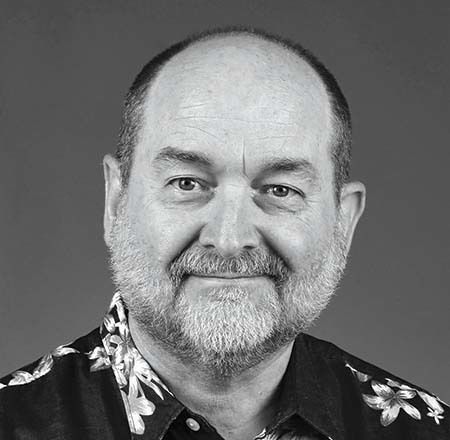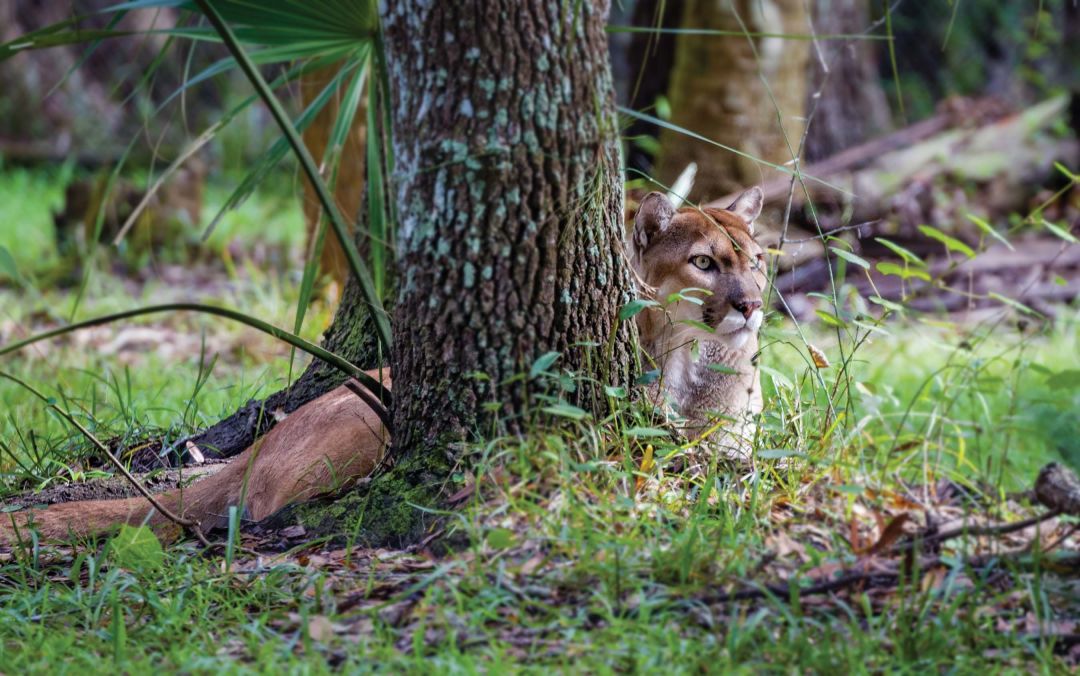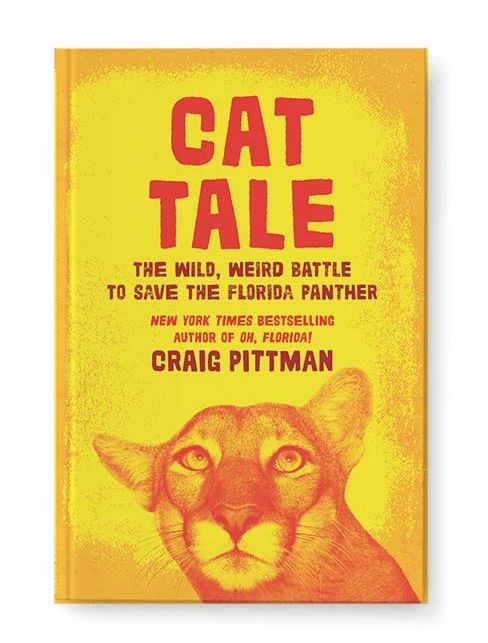
The Story of the Florida Panther Is Worth Telling
In 1981, Florida school children were asked to vote for Florida’s state animal and were given a ballot with three candidates: the manatee, the Key deer and the Florida panther. Maybe not surprisingly, they overwhelmingly voted for the dashing, tawny predator. Craig Pittman is thankful. School kids popularized this big cat, a feline most Floridians had never seen or really thought much about, helping to save it from extinction by funneling attention and then money in its direction. They also gave Pittman the beginnings of what he calls a “great yarn,” his new book Cat Tale: The Weird, Wild Battle to Save the Florida Panther (excerpted below).

Craig Pittman
Image: Dirk Shadd
A Florida native, Pittman is known for his love of this state, its great natural beauty and the odd losers, grifters, drifters and funny events that only seem to happen here. (He writes about this in another one of his five books, Oh Florida!: How America’s Weirdest State Influences the Rest of the Country.) An award-winning environmental reporter for the Tampa Bay Times for 20 years and also an award-winning freelancer for Sarasota Magazine, he was recently named the 2020 Literary Legend by the Florida Heritage Book Festival, an honor he shares with Zora Neale Hurston, John D. MacDonald and Carl Hiaasen.
Early on, Pittman says, he realized the story of the Florida panther was worth telling. The Florida panther is an umbrella species, which means that protecting the panther and the land that it roams on is vital to protecting other animals (including humans) and resources, such as water, that we need in Florida. But as in all good books, Cat Tale contains drama and an assortment of heroes and villains: inspiring, devoted biologists (women in science play pivotal, positive roles, he’s happy to say), committed government workers as well as corrupt ones, junk science, powerful developers, a taciturn Texan cougar hunter straight out of Hollywood casting, and a desperate dramatic experiment to introduce new cougar DNA into the Florida panther bloodline. When Pittman started his reporting on the panther, there were about 30 left in Florida. Today there may be as many as 230, and the panthers that are roaming and breeding are healthier. But their survival isn’t assured. Florida’s growth and pressure to develop and the politics of the state continue to encroach on their habitat.
Pittman remains cautiously hopeful about the panther’s future. In 2014, Floridians showed they cared about the environment when they voted for Amendment 1 to preserve endangered lands (although our politicians are misusing the funds, he says) and the Florida panther is popular. “People go nuts when they see one,” he says. “But habitat must be preserved. Panthers need more than isolated spots to roam.” —Susan Burns

The Florida panther
Image: Shutterstock
Excerpt from Chapter 14: “Florida Will Be Developed”
While most people think of Florida as being nothing but beaches and theme parks, ranchers own more than four million acres of pasture and range across the central and southern part of the state. Some of the ranchers can trace their family’s cattle holdings back to before the Civil War. As late as the 1890s, at a time when the West had stopped being so wild, Florida’s ranchers were still getting into range wars and hanging cattle rustlers from the nearest tree branch. The open range era lasted until 1949.
Some of the state’s remaining eighteen thousand or so ranchers have been careful to maintain their property as a good habitat for wildlife. Some, on the other hand, cannot wait to cash in by selling their land to developers or paving over it themselves. Some are not real ranchers, just real estate investors who have parked a few cows on their future development site to claim an agricultural exemption on their property taxes until they’re ready to cover it with concrete.
One of the ranchers ready to cash in was Ben Hill Griffin III. A beefy, bullet-headed businessman, Griffin was the only son and namesake of Florida citrus and cattle baron Ben Hill Griffin Jr., whose name is also on the University of Florida’s football stadium, aka “The Swamp.” Under the younger Griffin, the companies the family owned had begun to diversify beyond orange trees and cows, taking on everything from mining to sod-growing to real estate development. The Griffin family businesses controlled hundreds of thousands of acres, and more than a few politicians. To say the Griffin family is influential is like saying that Superman can lift heavy things.
In the early 1990s, the Legislature decided to build a new university—the state’s tenth—near Fort Myers. The lawmakers left it to the state Board of Regents to pick the site from three finalists culled from a list of twenty-two properties. One of the three finalists was, from an environmental standpoint, the worst possible choice. More than half of the land was swamp. It lay in a district zoned for conservation, to aid in recharging the underground aquifer. And it was designated as prime panther habitat. But it was owned by Ben Hill Griffin III, who had offered to donate it to the state at no charge.
Can you guess which one the Regents chose?
To Griffin, his land was ideal for the new campus: “It had the greatest access to I-75. It had a mile frontage on a 775-acre lake.” (Actually the “lake” was a rock quarry that had filled up with water, but somehow that never was mentioned.)
Griffin scoffed at the idea that panthers might live on his property. Weren’t they nearly extinct?
“The panther ain’t never been there, ain’t comin’ back,” he drawled. “You look close enough, you may find a dinosaur track out there, but I don’t think the dinosaur is coming back again.”
Griffin’s reasons for donating his land to the state were anything but altruistic. He owned all the property around the potential college campus, and he expected the new university to spark a major development boom in an area he had already envisioned as a new town. In other words, the Regents building the campus in that spot would destroy more than just six hundred forty acres of panther habitat. It would lead to the destruction of thousands of acres of habitat all around it too.
Whatever Griffin wanted in Florida, he usually got. Thus the state agencies that had to approve permits for the work did so, overriding the objections of their own staff biologists. But to get permission to build the college on such a soggy site, the Regents needed a wetlands destruction permit from the US Army Corps of Engineers. And to get that permit required approval of [the] agency for any potential impact on endangered species—panthers, for instance.
Corps officials were initially inclined to say no. The wetlands impact was too big and the reasoning behind it made no sense. After all, there were other, drier places to build the campus that would produce a smaller impact.
But then the calls began coming in from Griffin’s friends in the federal government. The colonel in charge of the Corps’s office in Jacksonville was out on an airboat in the Everglades one day when his cell phone rang. When he answered, his ear got blistered, but good, by Florida’s Republican senator, a Fort Myers banker named Connie Mack. The senator was cussing him out for not giving Griffin what he wanted right away.
Contrary to Griffin’s comments, panthers did indeed live there. A draft report by the Fish and Wildlife Service noted all the panther signs around Griffin’s property—tracks and scrapes and radio telemetry readings, not to mention the occasional roadkill. Each one was a strike against approving the permit there, according to David Ferrell, the Fish and Wildlife Service biologist who was then in charge of the agency’s regional office in the Atlantic Coast town of Vero Beach.
“We had seen a female migrating back and forth across there,” Ferrell told me when I finally tracked him down for an interview.…
Ferrell wanted to be sure his staff didn’t screw this one up. He said he made several visits to the site in 1993, accompanied by the state game commission’s top panther expert—David Maehr.
Griffin’s land, Ferrell told me, was “all soggy,” making him wonder how the Corps could possibly approve it…
“If they developed that area it would not be just the footprint of the campus but also all the apartments and the shopping malls and so forth,” he said. Wiping out so much habitat all at once would do more than just displace a few cats: “It would have an impact on breeding.”
In May 1994, Ferrell and his staff concluded that building the new university on Ben Hill Griffin III’s land would definitely jeopardize the future of panthers—and at a time when their future seemed particularly precarious. Captive breeding had failed and [Roy] McBride, [a biologist and famous puma tracker] had not yet gotten approval to bring in any Texas cougars, so there were no more than about thirty of the cats remaining. The idea of destroying hundreds of acres of their habitat seemed like folly.
“This is a direct and permanent loss of habitat that would be a fairly significant loss of panther habitat,” Ferrell told me. “We’d lose reproduction, we’d lose habitat. The population could begin to spiral downward.”
Someone shared the [U.S. Fish and Wildlife] draft with Griffin’s paid consultants, who showed it to him. He made a few phone calls. One of them went to Florida’s senior U.S. senator, Robert “Bob” Graham, a Democrat.
Graham was a wonkish, Harvard-educated lawyer whose family had made a fortune developing the Miami Lakes community in South Florida. His father is credited with being the first to plant sugar cane in South Florida. Yet the pudgy politician had convinced the voting public he was just a regular guy by creating what he called “Work Days” in which he would show up to work for one day a month at a regular-guy job: teacher, firefighter, sheriff’s deputy and so forth. Those made him popular enough to be elected to two terms as governor from 1979 to 1987, and then got him elected to a U.S. Senate seat. In office, he cultivated a reputation as a leader on environmental causes. He was among the first Florida politicians to push for restoring the Everglades, and he cofounded the Save the Manatee Club with singer Jimmy Buffett. Some people claimed he was the model for the character of Skink, the wily ex-governor turned eco-terrorist in Carl Hiaasen’s wacky Florida crime novels, although Graham wouldn’t be caught dead wandering the state’s highways clad in a loin cloth and a shower cap. He was also, incidentally, the governor who signed into law the declaration that the panther was the official state animal.
Yet now Graham was being asked by a major campaign donor for help in getting permission to wipe out a bunch of panther habitat. Without publicly endorsing the project, the senator agreed to provide some back-door assistance.

Cat Tale by Craig Pittman
Image: Courtesy Photo
On Sept. 26, 1994—a date which will, for panther fans, live in infamy—Ferrell’s bosses in Atlanta convened a meeting there. They did so at Graham’s request. Neither Ferrell nor his Vero Beach staff were invited. Neither were any of the state game commission’s panther experts. Instead, the attendees included Ben Hill Griffin’s attorney, two officials from Lee County (which was eager to see the university and its surrounding development get built) and—representing Griffin’s development consultants—Dave Maehr [formerly the state game commission panther expert who had shockingly switched sides].
If anyone took notes at that meeting, they were never made public. Years later, when a reporter asked Griffin what occurred that day, his response echoed the lyrics of an old Charlie Rich country hit: “Who knows what goes on behind closed doors?”
But the upshot of the meeting was clear as crystal…construction began, both on the campus of what was now called Florida Gulf Coast University and on the entrance road, which was named for Griffin. But when the students first arrived and tried walking around the still swampy grounds, they came up with a different name for the place: “Mildew U.” In less than ten years, the university would be fined three times for illegally pumping water off the campus, trying to dry the place out. More than one person wondered if Griffin had donated that property to the state because he would have had a hard time selling any houses he built there.
Adapted from Cat Tale @ 2020 by Craig Pittman, used with permission by Hanover Square Press/HarperCollins.